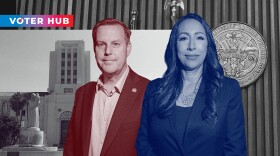The federal government sent a message to Wall Street this week: No more bailouts. Yes, the U.S. Treasury swooped in to save mortgage giants Fannie Mae and Freddie Mac. But no, officials would not put the taxpayer on the hook for problems at the investment banks Lehman Brothers or Merrill Lynch.
The Federal Reserve Board has taken some steps to try to stabilize things, though. If you had read all the way to the last paragraph of a press release it sent out on Sunday, you could see that the Fed was in fact offering a bailout — at least, a little one.
In this case, the largess is aimed at investment banks, which usually borrow money from day to day to keep things running. Investment banks used to package a bunch of home loans together and sell those to investors as so-called mortgage-backed securities. The individual monthly loan payments would then go to the investors, creating a constant flow of cash. But as a wave of foreclosures swept across the nation, those mortgage-backed securities became increasingly sketchy. Instead of being seen by bankers as solid collateral, they're now called toxic waste.
That situation left investment banks hard pressed to borrow money — a dangerous situation for the economy.
This weekend, the Fed put a solution in place. It loosened the rules for financial institutions so that the savings side of a large corporation — the same savings side where you bank your paycheck — could more easily lend money to the investment side. Under the old scheme, that kind of in-family lending was severely restricted. In the new world, institutions can lend money back and forth even without rock-solid collateral.
"Think about it as a family," says Ted Truman, a veteran of the Federal Reserve Board who is now at the Peterson Institute for International Economics. "There are probably limits on how much you should lend to your brother or your sister. But under emergency circumstances, you relax those limits and you lend to your brother or sister."
The catch is that if the brother or sister can't pay the loan back, the whole family could go bankrupt. This isn't just a problem for the banks, because the money the savings bank is lending out is actually your savings. Those savings are backed by the Federal Deposit Insurance Corp., the FDIC. But if the FDIC runs short of money, it will be backed by the federal government. The federal government, in this case, equals you, the taxpayer.
"We have to swallow hard when we think about the safety implications of this," says Patricia McCoy, a professor at the University of Connecticut Law School. "People's deposits are safe. But it could result in another large bill for taxpayers."
McCoy says the implicit backing of these new loans amounts to a kind of bailout. "The left hand says, 'We're drawing a line with Lehman Brothers.' And the right hand said, 'But we'll back you up in a completely different way.' "
Restrictions against in-family lending grew out of the Great Depression, says Art Wilmarth, a professor at George Washington Law School. Many banks failed because they were exposed to risk from their real estate and securities affiliates. Congress built a firewall between the investing and saving arms of financial firms to guard against another contagious collapse.
The system hasn't worked all that well. "Well, these are firewalls that seem to burn down the first time the fire comes anywhere close," Wilmarth says. "So how good a firewall is that?"
Wilmarth lists Citigroup, JPMorgan and Bank of America as examples of U.S. institutions affected by the change. Major foreign institutions are also affected, including Credit Suisse, Deutsche Bank and Barclays.
The Fed has loosened the restrictions on in-family loans before, but in limited ways. This new policy is not permanent — it's set to expire early next year.
Copyright 2022 NPR. To see more, visit https://www.npr.org. 9(MDAzMjM2NDYzMDEyMzc1Njk5NjAxNzY3OQ001))







